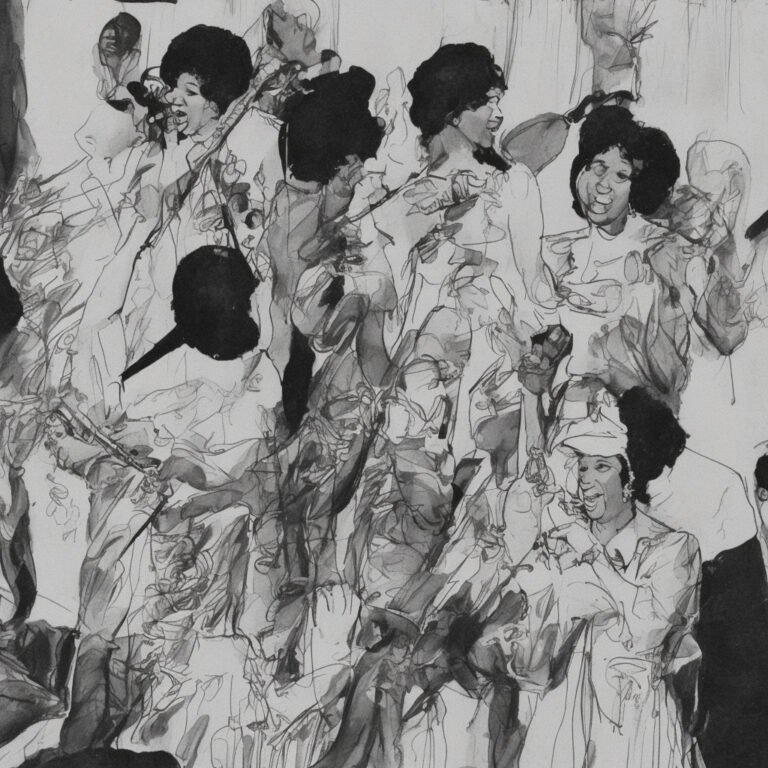? Did you know? #ArethaFranklin once turned down recording the legendary tune “Killing Me Softly”! ? It later became a hit for Roberta Flack. Aretha’s version would’ve been ?, right? ? #MusicTrivia #QueenofSoul #WhatIfs Read about it: tinyurl.com/43h7cnpk
Exploring the Queen of Soul’s Diverse Musical Journey
From Gospel to Grammy Glory: Unraveling the Queen of Soul’s Versatile Artistry and Timeless Impact.

Aretha Franklin, widely known as the Queen of Soul, had a diverse musical journey, spanning various genres and captivating audiences worldwide. Born in Memphis, Tennessee, in 1942, Franklin began her career as a child singing gospel at her father’s church. She was a musical prodigy, and by the time she turned 18, she had already signed a record deal with Columbia Records. Over the years, she recorded numerous hits like “Respect,” “Think,” and “Chain of Fools,” which earned her an impressive 18 Grammy Awards and countless other accolades.
While many people associate Aretha Franklin with powerful, soulful vocals and R&B music, her range and versatility extended far beyond that. One memorable example of this is her rendition of the song “Killing Me Softly.” Originally sung by Lori Lieberman and later popularized by Roberta Flack in 1973, “Killing Me Softly” is a tender, heartfelt ballad that has been covered by various artists over the years, including the hip-hop group Fugees.
Franklin’s performance of “Killing Me Softly” showcases her ability to adapt her signature voice to different musical styles. In this rendition, she effortlessly transitions from her powerful, belting voice to a gentle, emotive croon that is equal parts haunting and mesmerizing. This versatility distinguished her from many of her contemporaries and reaffirmed her status as a musical legend.
That being said, it’s essential to acknowledge that even legends may have their shortcomings. Critics often point to the sometimes inconsistent quality of Franklin’s live performances. However, this does little to diminish the impact and legacy she left on the music industry. Unfortunately, Aretha Franklin passed away in 2018, but her music continues to inspire and captivate generations of fans.
Throughout her illustrious career, Aretha Franklin’s contributions to music have been recognized with numerous honors and awards. Among her many accolades are a star on the Hollywood Walk of Fame, induction into the Rock and Roll Hall of Fame, and a Presidential Medal of Freedom. In 2019, she was posthumously awarded a special citation Pulitzer Prize, further solidifying her status as a musical icon.
In conclusion, Aretha Franklin’s rendition of “Killing Me Softly” serves as a testament to her diverse musical talents and her ability to leave a lasting impression on audiences. While her live performances may have occasionally faltered, her legacy as the Queen of Soul remains indisputable.
Charting the Journey of a Timeless Classic
“Tracing the soulful evolution of ‘Killing Me Softly’ from Lori Lieberman’s 1971 original to Aretha Franklin’s 2007 rendition, highlighting the timeless impact of this classic ballad.”

When it comes to “Killing Me Softly,” it’s important to note that the song was originally recorded by Lori Lieberman in 1971, and later popularized by Roberta Flack in 1973. However, Aretha Franklin’s rendition, which was released on her 30th studio album, “Jewels in the Crown: All-Star Duets with the Queen” in 2007, brought new life to the iconic ballad.
Upon its release on November 13, 2007, “Jewels in the Crown” debuted at number 121 on the Billboard 200 chart. Although the album itself did not hit the top of the charts, Aretha Franklin’s interpretation of “Killing Me Softly” showcased her unparalleled vocal prowess and ability to take on any song, making it a standout track on the album.
The original version by Roberta Flack, however, enjoyed immense chart success. It climbed to the number 1 position on the Billboard Hot 100 in 1973, and maintained its spot for a total of five non-consecutive weeks. The song also reached number 2 on the Easy Listening chart, and took home two Grammy Awards in 1974 for Record of the Year and Best Female Pop Vocal Performance. Additionally, the song reached the number 6 position on the UK Singles Chart.
While Aretha Franklin’s version of “Killing Me Softly” did not achieve the same level of chart success as its predecessors, it is an excellent example of her ability to leave her indelible mark on any song she performed. This may not have been a chart-topping rendition, but it certainly added to the rich legacy of both the song and the Queen of Soul herself.
Dissecting the Poetic Lyrics of a Timeless Classic
Strumming my pain with his fingers,
Singing my life with his words,
Killing me softly with his song,
Killing me softly with his song,
Telling my whole life with his words,
Killing me softly with his song.
I heard he sang a good song, I heard he had a style,
And so I came to see him, to listen for a while.
And there he was, this young boy, a stranger to my eyes,
Strumming my pain with his fingers,
Singing my life with his words,
Killing me softly with his song,
Killing me softly with his song,
Telling my whole life with his words,
Killing me softly with his song.
“Killing Me Softly,” originally written by Charles Fox and Norman Gimbel in 1971, became a popular hit when it was covered by Roberta Flack in 1973. Despite popular belief, Aretha Franklin did not sing this song. The song’s lyrics are a poetic expression of the intense emotional connection one can feel with a musician through their music. The protagonist of the song describes how the singer’s voice resonates with her own life experiences, causing her to feel vulnerable and exposed.
The early 1970s was a time of significant change and self-reflection in the United States. The Vietnam War was coming to an end, the Watergate scandal was unfolding, and the civil rights movement was making progress. Amidst these events, people were searching for solace and meaning in their lives. In this context, “Killing Me Softly” captured the spirit of the time as it portrayed the deep emotional relationship individuals can form with music.
The lyrics convey how the singer’s voice and lyrics seem to tell the protagonist’s life story, making her feel simultaneously comforted and exposed. This emotional connection represents the power of music to create a shared understanding of human experiences, transcending physical presence and fostering empathy amongst people.
Overall, “Killing Me Softly” is a timeless classic that speaks to the power of music and its ability to connect us with one another. Its lyrics continue to resonate with audiences today, proving that great art has the capacity to transcend time and touch the hearts of people no matter the generation.
Killing Me Softly: The Visual Treat
Dive into Aretha’s enduring legacy with fan-made visual treats and soulful covers of “Killing Me Softly,” celebrating the Queen of Soul’s timeless magic and influence.
It’s worth noting that “Killing Me Softly” is a song famously recorded by Roberta Flack in 1973 and later popularized by the Fugees in 1996. While Aretha Franklin’s rendition of the song has been praised by many, it does not have an official music video. However, there are several fan videos and YouTube tributes for Aretha’s version that showcase the Queen of Soul’s incomparable voice and unique musical prowess. These visual creations pay homage to the iconic singer and her powerful take on this classic song.
One such fan video brings together vintage footage of Aretha Franklin performing live, with the audio of her rendition of “Killing Me Softly.” The montage of clips includes footage from her concerts, TV appearances, and interviews, highlighting her legendary career and the impact she’s had on the music industry. This video serves as not only a tribute to Aretha’s version of the song but also a celebration of her incredible musical journey.
In addition to fan-made videos, there are various YouTube covers of Aretha Franklin’s version of “Killing Me Softly” by aspiring and established artists alike. These covers showcase the influence that the Queen of Soul has had on musicians across generations, genres, and backgrounds. Many performers attempt to capture Aretha’s passion and vocal prowess in their interpretations, resulting in a diverse array of performances that are a testament to her undeniable musical influence.
While there isn’t an official music video for Aretha Franklin’s rendition of “Killing Me Softly,” the outpouring of fan videos, tributes, and covers on YouTube acts as a testament to the enduring legacy of the Queen of Soul. These visual offerings provide an opportunity for fans and newcomers alike to appreciate Aretha’s powerful voice and emotional delivery, reminding us all of the timeless magic she brought to the world of music.
The Mastermind Behind “Killing Me Softly”: Composer Charles Fox
Charles Fox, the talented composer behind “Killing Me Softly,” has an illustrious career spanning over five decades, cementing his status as a musical legend. He teamed up with lyricist Norman Gimbel to create this timeless masterpiece, which was later popularized by Roberta Flack and then famously covered by Aretha Franklin. Fox’s penchant for creating unforgettable tunes doesn’t stop there; in collaboration with Gimbel, they also penned the iconic “I Got a Name,” which became a signature song for the late Jim Croce.
Fox’s musical prowess extends beyond pop classics – this versatile composer has also crafted memorable scores for film and television, notably the themes for “Love Boat,” “Happy Days,” and “Laverne & Shirley.” It’s safe to say that Charles Fox’s contributions have left an indelible mark on the world of music, one beautiful melody at a time.
Accolades, Appearances, and Cover Versions
“Killing Me Softly” – A Timeless Classic Melting Hearts with Accolades, Media Features, and Genre-Defying Covers.

“Killing Me Softly” has undoubtedly left an indelible mark on the music world, garnering numerous awards and accolades over the years. The song won the 1974 Grammy Awards for both Record of the Year and Best Female Pop Vocal Performance, establishing its place as a timeless classic. Additionally, the songwriters, Charles Fox and Norman Gimbel, were awarded the prestigious Songwriters Hall of Fame’s Towering Song Award in 2008 for their contributions to this beloved tune.
The song’s impact extends beyond the music world, as it has been featured in various forms of media throughout the years. “Killing Me Softly” could be heard in the 1996 film “The Pallbearer,” starring Gwyneth Paltrow and David Schwimmer, adding emotional depth to the movie’s narrative. Additionally, the song has been used in various television shows, such as “American Idol,” “The Voice,” and “Glee,” showcasing the talents of aspiring artists and providing a platform for the song’s continued legacy.
One of the reasons “Killing Me Softly” has remained a cultural touchstone is the numerous cover versions that have been produced by artists across various genres. The most famous of these is undoubtedly the Fugees’ 1996 rendition, which topped charts worldwide and introduced the song to a new generation of listeners. Lauryn Hill’s soulful vocals and the group’s unique blend of hip hop and R&B elements gave the song a fresh and contemporary sound, revitalizing its appeal.
Apart from the Fugees, other notable musicians have also lent their voices to reinterpretations of the song. For instance, the late great Aretha Franklin, known as the Queen of Soul, delivered a powerful rendition during her live performances, showcasing both her incredible vocal range and the song’s ability to transcend genres. Additionally, international superstar Celine Dion has performed “Killing Me Softly” during her concerts, demonstrating the song’s universal appeal and endurance throughout time.
In conclusion, “Killing Me Softly” continues to resonate with audiences worldwide, earning accolades, featuring in movies and television shows, and inspiring various cover versions. Its timeless message and soulful melody ensure its place in the pantheon of unforgettable classics, remaining just as relevant today as it was when it was first released.
Dissecting the Musical Anatomy
“Killing Me Softly” by Aretha Franklin showcases a masterful blend of R&B, soul, and gospel elements, which come together to create a timeless classic. The song is written in the key of D minor, and it features a simple yet captivating chord structure that allows the listener to focus on the powerful delivery of the lyrics.
The overall structure of the song follows the classic verse-chorus-verse pattern, with the introduction of pre-choruses and interludes that add variety and keep the listener engaged. The chord progression for the verses is Dm7 – Gm7 – A7 – Dm7, while the chorus features a slightly different progression of F – Gm – A7 – Dm7. This subtle shift in chords adds emotional depth to the song and highlights the poignant nature of the lyrics.
In terms of tempo, “Killing Me Softly” is set at a moderate pace of approximately 72 beats per minute (BPM). This slow-burning tempo allows Aretha Franklin’s phenomenal vocal range and expressiveness to shine through, as she navigates the song’s intricate melody with effortless grace.
One of the standout features of this track is the use of syncopation, which can be heard in both the piano and the drums throughout the song. Syncopation creates an offbeat rhythmic pattern that adds an element of surprise and excitement to the music. This technique is particularly effective in the chorus, where the syncopated rhythm of the piano chords is complemented by the steady beat of the drums, creating a rich and engaging soundscape.
Another key aspect of “Killing Me Softly” is the use of dynamics to accentuate the emotional weight of the lyrics. Aretha Franklin skillfully employs vocal dynamics to convey the pain and heartache expressed in the song, while the instrumentation follows suit, with the intensity of the music swelling and subsiding in perfect harmony with the vocals.
In addition to the main melody, the song features a number of countermelodies and harmonies that further enhance its musical complexity. The backing vocals, for instance, provide a lush harmonic backdrop that adds depth and richness to the overall sound. Moreover, the interplay between the piano, bass, and strings creates a multi-layered texture that showcases the song’s intricate arrangement.
In conclusion, the musical structure of “Killing Me Softly” by Aretha Franklin is a testament to the artistry and craftsmanship that went into creating this iconic track. From the subtle nuances of the chord progressions and tempo to the masterful use of dynamics and syncopation, every element of this song works in harmony to deliver a powerful and memorable listening experience.







